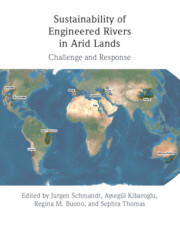Book contents
- Sustainability of Engineered Rivers in Arid Lands
- Sustainability of Engineered Rivers in Arid Lands
- Copyright page
- Dedication
- Contents
- Contributors
- Part I Introduction
- Part II Challenge
- 2 Global Climate Change and the Rivers
- 3 Reservoirs
- 4 Depletion of Groundwater
- 5 Endangered Food Security
- 6 Declining Environmental Flows
- Part III Engineered Rivers
- Part IV Response
- Part V Conclusion
- Index
- References
3 - Reservoirs
Design, Functions, Challenges
from Part II - Challenge
Published online by Cambridge University Press: 16 September 2021
- Sustainability of Engineered Rivers in Arid Lands
- Sustainability of Engineered Rivers in Arid Lands
- Copyright page
- Dedication
- Contents
- Contributors
- Part I Introduction
- Part II Challenge
- 2 Global Climate Change and the Rivers
- 3 Reservoirs
- 4 Depletion of Groundwater
- 5 Endangered Food Security
- 6 Declining Environmental Flows
- Part III Engineered Rivers
- Part IV Response
- Part V Conclusion
- Index
- References
Summary
A reservoir is a replacement of a segment of the river with a watercourse that is quite different, a larger, more quiescent water body with different water quality and capable of stratification. This chapter describes design and functions of river reservoirs. The main challenges faced by SERIDAS reservoirs are highlighted. Special attention is given to a reservoir’s dependable yield, which can be maintained constantly without failure throughout the time history of reservoir storage. All reservoirs act as sediment traps and will eventually silt up unless special actions are taken to manage sediment. Reservoirs significantly alter the hydrology of the river downstream from the dam and can affect its water quality and its ecosystem. With increases in population and agriculture, water demands will increase, exacerbated by climate changes. Skillful management will be needed to temper conflicts that arise over how reservoirs will be operated under situations of incompatible objectives.
- Type
- Chapter
- Information
- Sustainability of Engineered Rivers In Arid LandsChallenge and Response, pp. 31 - 45Publisher: Cambridge University PressPrint publication year: 2021



